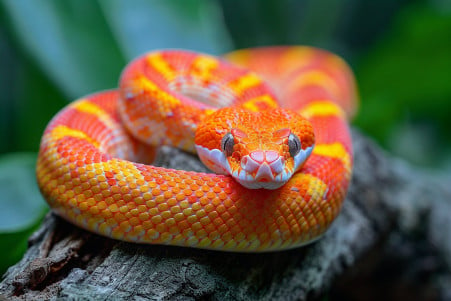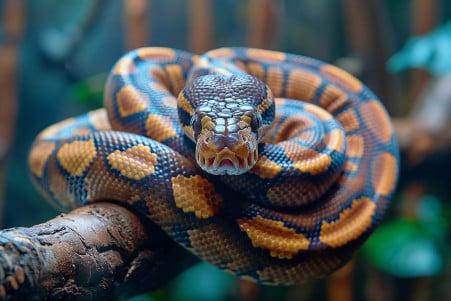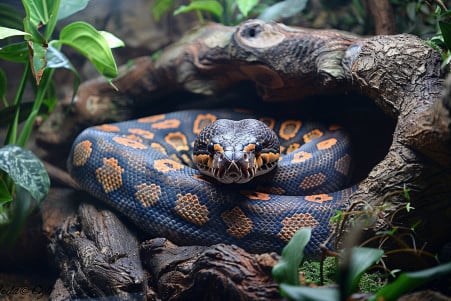How Long Do Ball Pythons Live?
2 February 2024

Ball pythons are popular pets, but you may be wondering how many years you’ll be able to spend with your scaly friend. Ball pythons, which are one of the most popular snakes to keep as pets, have a lifespan of 20 to 30 years in captivity, although some have been known to live to be 40 years old with the right care. Their lifespan is influenced by their diet, living conditions, and genetics.
In this article, we’ll explore herpetological and veterinary research to help you better understand how long ball pythons live. We’ll also look at how the care they receive, the environment they live in, and biological factors all work together to determine their lifespan.
By combining information from care sheets written by experts and scientific studies, we hope to give you a complete picture of how to help these interesting reptiles live long, healthy lives.
What are the primary factors that influence the lifespan of ball pythons in captivity?
Most Important Factors That Affect Ball Python Lifespan in Captivity
The lifespan of ball pythons in captivity can vary quite a bit, but most will live between 20 and 30 years. Some have even lived longer, with the longest-lived ball python on record living to be 47 years old at the Philadelphia Zoo. According to Animal Bliss, this is much longer than ball pythons live in the wild and is due to the controlled environment, regular feeding, and medical care that captive ball pythons receive.
Diet and habitat are the two most important factors in a ball python’s health and lifespan. A proper diet, feeding schedule, and a habitat that is as close to their natural environment as possible are key.
According to Reptiles Magazine, this means that their enclosures should be large and that the temperature and humidity should be kept at levels that mimic the African grasslands where they originated. This will help ensure that they are not only physically healthy but also mentally healthy.
Just as important are regular vet check-ups. According to PetMD, annual visits to the vet are important, as is knowing the signs of common health problems, such as respiratory infections and issues with shedding.
Catching these problems early can prevent them from becoming life-threatening and help ensure that ball pythons live as long as possible.
In order to make sure that ball pythons live as long as possible, it’s important that their owners pay close attention to their diet, make sure that their habitats are as close to their natural environment as possible, and make sure that they are getting regular medical care. All of these things can help ensure that they live a long and healthy life in captivity.
Diet Is Key to Ball Python Longevity
In order to live long, healthy lives, ball pythons need to eat a healthy diet. As reptiles with slow metabolisms, they eat rodents that are about the same size as they are, or as wide as their bodies.
The Reptile Rescue Center suggests that hatchling ball pythons should be fed mice or rat pups every 5–7 days, while adults should be fed every 7–10 days. This will ensure that they get the nutrients that they need without the risk of obesity, which is a common result of overfeeding and can significantly reduce their lifespan.
An unbalanced diet can lead to nutritional deficiencies, which can cause a number of health issues. Animal Diversity Web explains that a diet that is high in rodents is important for carnivorous snakes like ball pythons, as it mimics their natural diet and helps them live longer.
Feeding them pre-killed or frozen/thawed prey, which the Reptile Rescue Center suggests, not only ensures that they get the nutrients that they would in the wild, but also protects them from the injuries that can come from live feedings, which can help ensure their overall health and longevity.
Nutrition is the basis of the overall health of ball pythons, which in turn impacts every part of their biology, including the complex relationship between genetics and how long they live.
Genetics and Heredity
Genetics are a major factor in the lifespan of ball pythons, not only because they determine the snake’s likelihood of developing certain diseases but also because they can influence how long the snake is likely to live.
A study published in Science found that, in reptiles and amphibians, those with protective phenotypes—traits that help protect against predators or other environmental dangers—have slower rates of aging. This suggests that the genetic factors that lead to protective phenotypes may also influence the lifespan of ball pythons.
The idea of negligible aging—where a species shows no or very little signs of aging—has also been seen in reptiles. These studies have shown that some reptiles may not age biologically in the same way that mammals do, which could have an impact on ball pythons.
By studying the genetics of reptiles that are known to have negligible aging, researchers may be able to learn more about the genes that determine the lifespan of ball pythons.
According to Functional Ecology, an integrative approach that looks at gene regulatory networks, cell signaling pathways, and more is needed to understand the genetic basis of aging in reptiles. However, this kind of research could help us better understand the genetic and hereditary factors that impact the health and lifespan of these popular pets, potentially leading to better care and longer lives for our snake friends.
Reproductive Cycles and Their Impact on Longevity
Ball pythons have a distinctive reproductive cycle, with most reaching sexual maturity between the ages of 3 and 5. They reproduce through oviparous reproduction, or egg-laying, and females are particularly well-known for their maternal instincts, often wrapping around their eggs to keep them warm until they hatch.
Yet, there may be costs associated with reproduction. A study in Oecologia by Richard Shine found that reptiles, including ball pythons, experience costs of reproduction, including increased predation risk and lower survival rates for gravid females.
This is an example of an evolutionary trade-off, where the current costs of reproduction may lower future survival and fecundity. While Shine’s research focuses on Australian skinks, it raises questions that could be relevant to other reptiles, including ball pythons, about the impact of intensive breeding on their longevity.
Moreover, the energy that goes into the reproductive cycle can impact the health of a ball python and, in turn, its lifespan. For example, females may experience stress during the egg-laying process, which can impact their overall health.
This goes back to the larger point that managing reproductive health is important for ensuring that these animals live long lives. This underscores the need to balance breeding with the health of ball pythons to support a long and healthy life.
Creating Enriched Environments to Improve Ball Python Longevity
Environmental enrichment is a critical component of improving the welfare of captive animals, including ball pythons. It goes beyond meeting the animal’s basic needs and includes the addition of stimuli that promote natural behaviors, thereby improving the animal’s mental and physical health. As noted in Environmental Enrichment for Amphibians and Reptiles, environmental enrichment can be defined as anything that positively changes an animal’s umwelt, or perception of its environment.
Enrichment that stimulates the senses of ball pythons and encourages natural feeding behaviors can have a big impact on their health. This can include using scent trails to encourage hunting and adding different textures to the enclosure to encourage tactile exploration.
A study by Andrea L. Fidgett in the Journal of Zoological and Botanical Gardens found that sensory and feeding enrichment led to a significant increase in exploratory behavior in reptiles, which was more similar to their natural behavior.
This can lead to increased activity and decreased stress, which could lead to a longer life for these animals. By adding enrichment that is based on their natural ecology, owners can create environments that will help ensure the longevity and well-being of their pet ball pythons.
Stress and How to Reduce It in Ball Pythons
Stress can have a major impact on the health and longevity of ball pythons. Physiological signs of stress in these reptiles can range from changes in eating patterns to a weakened immune system to more subtle signs like changes in body postures.
In terms of behavior, stressed ball pythons may show signs of avoidance, increased aggression, or increased time spent hiding. In her work, Nicola J. Nelson has shown that stress can disrupt normal reproductive behaviors and success in reptiles, which can have a major impact on their overall well-being.
Chronic stress can also make ball pythons more vulnerable to a variety of health problems, including disease, because it suppresses their immune system. A study by Martinez Silvestre on reptiles notes that it’s important to understand and recognize stress responses so that long-term negative impacts on reptile welfare can be avoided. After all, long-term stress can reduce a ball python’s life expectancy by suppressing its immune system and potentially impacting its ability to reproduce.
To reduce stress in captive ball pythons, owners should work to create a stable environment that limits potential stressors, such as handling and changes in their environment.
In fact, research by Oliver H.P. Burman on bearded dragons, which has been used to inform best practices for handling, has shown that gentle and infrequent handling can reduce stress-related behaviors. By following similar guidelines with ball pythons, owners can help ensure that their pets live longer, healthier lives.
A Few Last Thoughts on Ball Python Lifespan
As you can see, with proper care, ball pythons can live a long time in captivity, often up to 20 to 30 years and sometimes even longer. Things like a healthy diet, the right conditions in their habitat, regular vet visits, and stress reduction play a big role in how long they live. So does a commitment to environmental enrichment and an awareness of the impact of breeding.
It’s important for pet owners to understand the genetic predispositions and hereditary factors that can impact these animals so that they can take the best care of them. It’s also important for pet owners to make sure that the environments they create for their pets meet their basic needs and allow for their natural behaviors, which will help them stay healthy and live as long as possible.
Finally, it’s important to remember that ongoing research is critical. It will help us learn more about the specific needs of ball pythons, improve our care of them, and help us make sure that they have the best lives possible. By keeping up with the latest research and using it to inform our care, we can make sure that our scaly friends have long, happy lives in our care.


